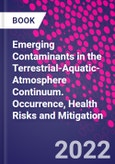Emerging Contaminants in Terrestrial and Aquatic Environments: Occurrence, Health Risks, and Mitigation provides the latest information on the synthesis of the occurrence, behavior, human health risks and mitigation of emerging contaminants in developing countries. First highlighting sources, industrial applications, key drivers and regulatory frameworks, the book then goes on to discuss the nature of emerging contaminants, including organic (e.g., pharmaceuticals), inorganic (e.g., rare earth elements) and biological agents (e.g., antimicrobial resistance). It then presents the dissemination, environmental behavior, and fate in terrestrial and aquatic systems as well as the human and ecological exposure pathways, health risks, and more.
Offering a transdisciplinary approach that brings together perspectives and contributions from experts in environmental sciences, hydrology, environmental engineering, ecotoxicology, chemistry, material sciences, and legal and policy aspects, the book provides an approachable and flexible resource for researchers and upper-level students with diverse academic backgrounds.
Please Note: This is an On Demand product, delivery may take up to 11 working days after payment has been received.
Table of Contents
Section A
Introduction to emerging contaminants
1. Emerging contaminants: A handful of conceptual and organizing frameworks
2. Emerging contaminants in the terrestrial-aquatic-atmosphere continuum: A global perspective
Section B
Emerging contaminants in terrestrial systems
3. High-technology rare earth elements in the soil system: Occurrence, behaviour, and fate
4. (Micro)plastics in the soil system: Occurrence, behaviour, fate, and future directions
Section C
Emerging contaminants in aquatic systems
4. Occurrence and behaviour of emerging organic contaminants in aquatic systems
5. Anthropogenic rare earth elements in aquatic environments: Occurrence, behaviour, and fate
6. Microplastics in aquatic systems: Research focal areas, understudied matrices, and future research needs
7. Antibiotic-resistant bacteria and antibiotic resistance genes in aquatic systems: Occurrence, behaviour, and fate
Section D
Emerging contaminants in atmospheric systems
8. Air-borne emerging contaminants: An under-studied reservoir and a potential health risk?
9. Occurrence, behaviour, and fate of airborne microplastics
Section E
Ecological health risks
10. Ecological health risks of hightechnology rare earth elements
11. Ecological health risks of antibiotic resistance: A perspective on the evidence, challenges, and research needs
12. Ecological health risks of emerging organic contaminants
13. Occurrence and ecological health risks of microplastics
Section F
Human health risks
14. Rare earth elements: Human exposure, risk factors, and health risks
15. Occurrence, human exposure pathways, and health risks of microplastics
16. The environmental resistome: Human exposure, health risks, and research needs
Section G
Risk assessment and mitigation
17. Assessment and mitigation of pollution and health risks of emerging contaminants: A call for an integrated approach
18. Emerging contaminants: Approaches for policy and regulatory responses in low-income countries
19. Remediation technologies for contaminated soil systems
20. Bio- and chemical surfactants for remediation of emerging organic contaminants
Section H
The research agenda
21. Ten (10) key research questions on emerging contaminants and novel entities, and their health risks
22. Emerging contaminants: Epilogue, next-frontier novel entities, and a look ahead








